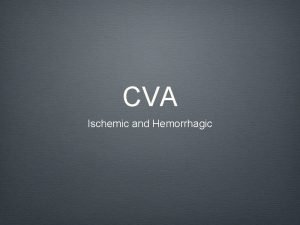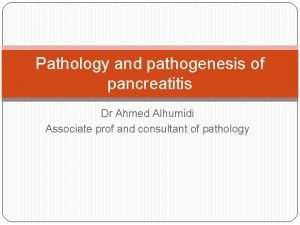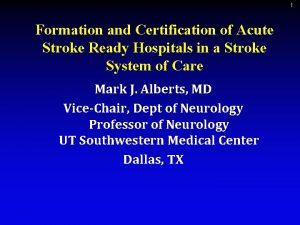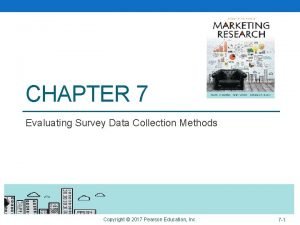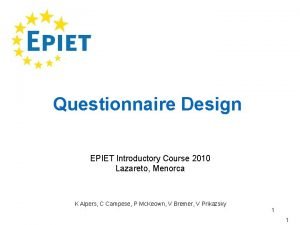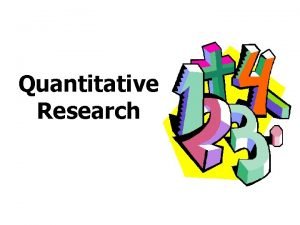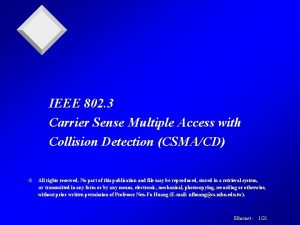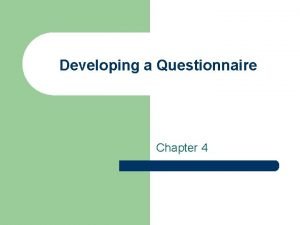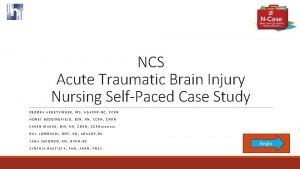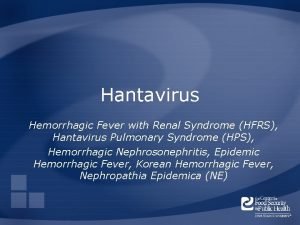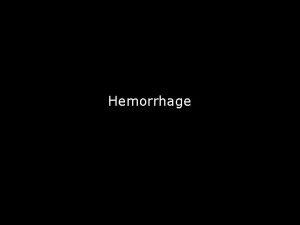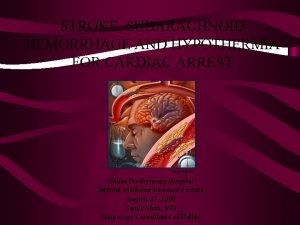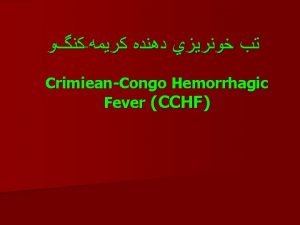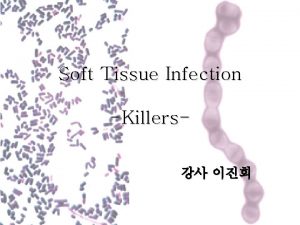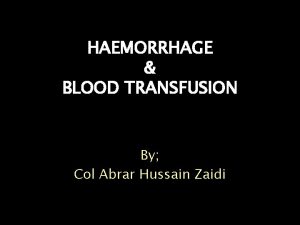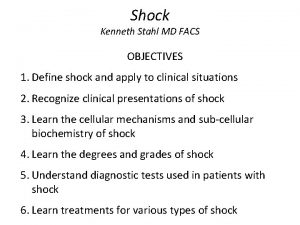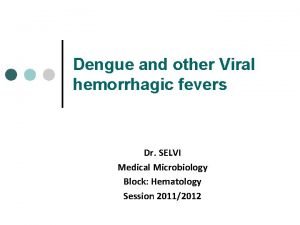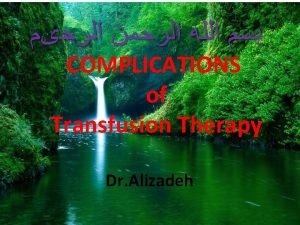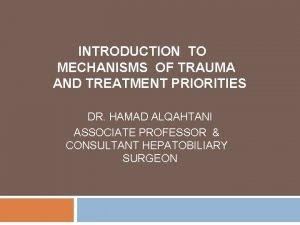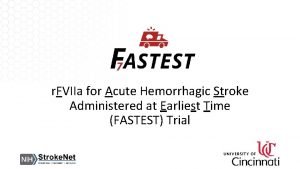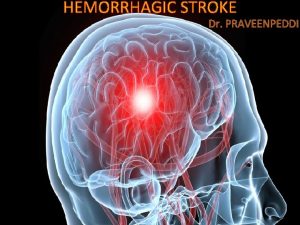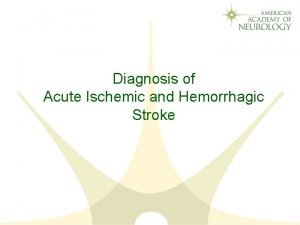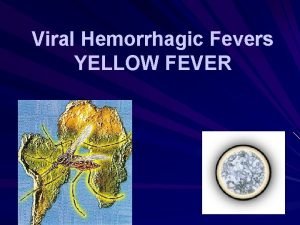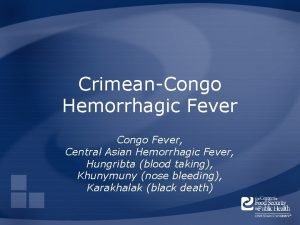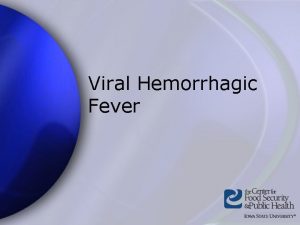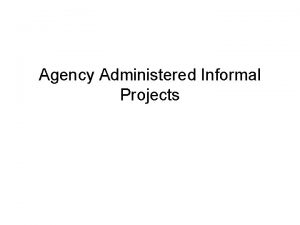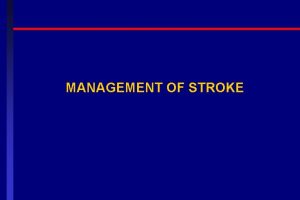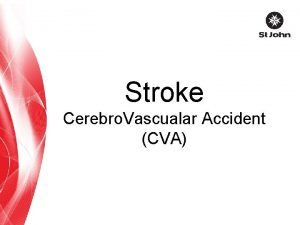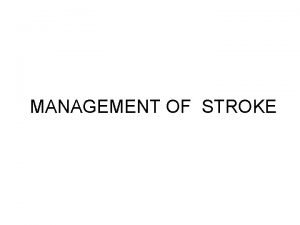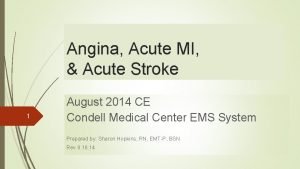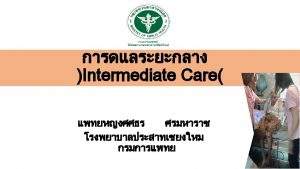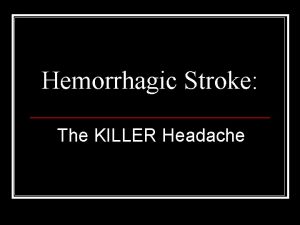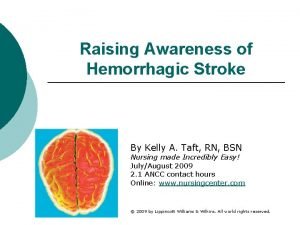r FVIIa for Acute Hemorrhagic Stroke Administered at










































































- Slides: 74

r. FVIIa for Acute Hemorrhagic Stroke Administered at Earliest Time (FASTEST) Trial

Webinar Agenda 12: 30 pm – 1: 00 pm – 1: 30 pm Welcome/FASTEST Trial Overview FASTEST: EFIC & IRB Issues FASTEST: EFIC Processes & Tools 1: 30 pm – 2: 00 pm Q&A Joseph Broderick, MD Luke Gelinas, Ph. D & Judith Carrithers, JD, MPA Pooja Khanolkar, MPH All June 22, 2020

Outline for the FASTEST Trial Overview • Discuss what is a brain hemorrhage or intracerebral hemorrhage (ICH) • Explain what is recombinant Factor VIIa (r. FVIIa) • Explain the FASTEST Trial and what it is trying to accomplish • Introduce emergency research and consent (Exception from Informed Consent (EFIC))

What is a Brain Hemorrhage?

ICH: Old or Damaged Blood Vessels Break Under Pressure

Background • Brain hemorrhage or intracerebral hemorrhage (ICH) is a type of stroke that accounts for more than 10% of the estimated 17 million strokes worldwide each year, or about 1, 700, 000 cases per year • More than 40% of patients die and only 20% of survivors are functionally independent at 6 months • The amount of blood in the brain is the most important determinant of outcome, and most bleeding occurs within 2 -3 hours • There is no scientifically proven effective treatment for ICH

SIZE MATTERS! Small Increases in ICH Volume Cause Significant Increase in Mortality Ping-pong ball vs. Golf ball 31 m. L 41 m. L ICH (N=188) Overall mortality 44% 0 -29 cm 3 Mortality 19% 30 -60 cm 3 Mortality 20%-55% ≥ 60 cm 3 Mortality 91% Only 1 of 71 patients with ICH volume ≥ 30 cm 3 functioned independently at 30 days (Oxford Handicap Score ≤ 3) Broderick, Stroke. 1993; 24: 987 -993

Learn from patients, your wife, and your colleagues J. Neurosurg: 72: 195 -199, 1990

Learn from patients, your wife, and your colleagues • Ellipsoid volume 4/3π(A/2)(B/2)(C/2) • ABC/2

Early hemorrhage growth in patients with ICH • First prospective study of ICH growth • 103 patients scanned < 3 hours of onset • 38% experienced significant hematoma growth (> 33% increase in volume) • 26% between baseline and 1 -hour scan • 12% between 1 - and 20 -hour scan • ICH growth was associated with clinical deterioration on NIHSS Brott, Broderick, et al 1997, Stroke. 1997; 28: 1 NINDS funded study

Physiologic time is critical for hemostatic therapy Salman et al, Lancet Neurology, September, 2018 – Figure A, demonstrates the strong exponential relationship between time from onset and predicted probability of growth of ICH of > 6 cc.

Current treatment of ICH • Admission to intensive care unit • Treatment of blood pressure, which is often very elevated • Often ventilator machine to help breathe • Medical and surgical treatments to help relieve pressure in the brain • Occasionally, surgery to remove blood • There is no scientifically proven effective treatment for ICH

Medications that Plug Leak: PPC in Warfarin-ICH (INCH Trial) Outcome FFP N=23 PCC N=27 P-value INR<2 within 3 hours 2 (9%) 18 (67%) 0. 003 Death at 90 days 8 (35%) 5 (19%) 0. 14 ICH expansion at 24 hours (ccs) 22. 1 (27. 1) 8. 3 (18. 3) 0. 048 >33% expansion at 24 hours 12/20 (60%) 8/27 (30%) 0. 024 Steiner, et al. Lancet Neurology, 2016

What is recombinant Factor VIIa (r. FVIIa)? • Factor VIIa is a normal protein in our body that helps stop bleeding • Recombinant Factor VIIa (identical to Factor VIIa but given in much larger amounts) is the only medication that has been shown to substantially decrease bleeding in patients with hemorrhage in the brain • It is easily administered intravenously with rapid onset of action • It is approved for other medical indications that involve bleeding (hemophilia) but not for brain hemorrhage • Prior trials of r. FVIIa showed that it slowed bleeding in the brain but that its benefits in improving outcomes are most likely when given within 2 hours of onset of symptoms

r. FVIIa Accelerates and Strengthens Local Hemostasis via a Unique Mechanism of Action 1. INITIATION: Tissue Factor/FVIIa interaction leads to thrombin generation 2. AMPLIFICATION: r. FVIIa activates Factor X on the surface of activated platelets, leading to an enhanced thrombin burst at the site of injury 3. FIBRIN CLOT FORMATION: Thrombin converts fibrinogen into fibrin, producing a stable clot Hoffman, M, et al. Thromb Haemost 2001; 85: 958.

Potential risks of r. FVIIa in patients with ICH • Since r. FVIIa helps stop bleeding by stimulating formation of and enhancing blood clots, patients with brain hemorrhage are also at risk for other vascular diseases and blood clots where there are damaged blood vessels – there is a risk of heart attack, stroke due to blockage of brain arteries, and clots in the lung • In prior studies, this occurred about 5% more commonly in persons treated with r. FVIIa as compared to placebo

Estimated Mean Percent Change in ICH at 24 Hours: Phase 2 b Trial 29% P=0. 012* 16% P=0. 015* 14% 11% Placebo 40 µg/kg 80 µg/kg 160 µg/kg Combined Treatment Covariates include baseline ICH volume, time-to-CT, and CT-to-needle time

Kaplan-Meier Survival Curves: Phase 2 b Trial P=0. 02, r. FVIIa combined vs. placebo New Engl J Med 2005; 352: 777 -785

Modified Rankin Scale at Day 90: Phase 2 b Trial 160 µg/kg 80 µg/kg m. RS 0 -1 m. RS 2 -3 m. RS 4 -5 m. RS 6 40 µg/kg Placebo 100% 80% FULL RECOVERY 60% 40% 20% 0% DEATH Global adjusted odds ratio for improvement on m. RS 2. 2, P=0. 004 New Engl J Med 2005; 352: 777 -785

Difference From Placebo in Absolute ICH Growth at 24 Hours (m. L) FAST Trial: Absolute Reduction in ICH Growth (m. L) 80 µg/kg by Treatment Time <2 Hours <3 Hours <4 Hours

FAST Trial: Modified Rankin Scale – Distribution at Day 90 No Difference Between Treatment Groups

Post-hoc analysis of subgroup from FAST Trials Mayer et al, Stroke, 2009

FASTEST subgroups from FAST and Phase 2 b studies Minutes from onset to treatment in patients age ≤ 80 ≤ 150 ≤ 140 ≤ 130 ≤ 120* Minutes from onset to treatment in patients age ≤ 70 ≤ 150 ≤ 140 ≤ 130 ≤ 120 FAST m. RS 0 -2 FVIIa m. RS 0 -2 Placebo 42% 46% 49% 52% 41% 41% 38% m. RS 0 -2 FVIIa 53% 59% 62% 69% Absolute % in m. RS 0 -2 in favor of r. FVIIa at 90 days 0% 5% 9% 14% Absolute % in m. RS 0 -2 -2 in favor of r. FVIIa Placebo at 90 days 39% 14% 38% 21% 38% 24% 33% 36% *N=25 in FVIIa and 32 in placebo group Phase 2 b Minutes from Absolute % in m. RS 0 onset to m. RS 0 -2 2 in favor of r. FVIIa at treatment in FVIIa Placebo 90 days patients age ≤ 80 ≤ 150 42% 32% 10% ≤ 140 47% 30% 17% ≤ 130 50% 25% ≤ 120 50% 20% 30%

FASTEST Trial: Objective • The objective of the r. FVIIa for Acute Hemorrhagic Stroke Administered at Earliest Time (FASTEST) Trial is to establish the first treatment for acute ICH within a time window and subgroup of patients that is most likely to benefit NIH Funded: 1 U 01 NS 110772 -01

Design • Randomized, double-blind controlled efficacy trial of r. FVIIa plus best standard therapy vs. placebo plus best standard therapy (including INTERACT 2 goal of target systolic blood pressure of 140 mm Hg) • Includes patients: • Age 18 -80, inclusive • Baseline volume of spontaneous ICH ≥ 2 cc and < 60 cc (measured by ABC/2 or by an FDA-cleared automated ICH volume imaging software (e. g. , VIZ. ai)) • No or small volume of IVH (IVH score ≤ 7) • Treated within 120 minutes of stroke onset/last known well (goal: ½ treated within 90 minutes)

Who does not qualify for FASTEST? • Persons who already are in a deep coma, or who have very large areas of bleeding in the brain and are already destined to die • Persons with recent heart attacks, strokes, or blood clots (within the prior 3 months) • Persons on blood thinners, such as warfarin • Women known to be pregnant • Persons who have an opt-out card

How to Minimize Time to Treatment • Exception from Informed Consent (EFIC) • Including remote and e. Consent options in the event a legally authorized representative or family member is available to provide prospective consent • Mobile stroke units (MSUs) • Improved acute stroke treatment processes, as for ischemic stroke, including automated calculation of ICH volume, door to needle, etc.

Intervention • Randomize participants in a 1: 1 ratio to intravenous r. FVIIa or placebo at a dose of 80 µg/kg (maximum 10, 000 µg or 10 mg) and administered intravenously over 2 minutes – all investigators and participants will be blinded throughout the course of the trial • Enrollment and randomization in the trial will occur upon injection of the study medication • Only a baseline non-contrast CT is required • CT angiogram will be collected, if done, but is not required

Additional Key Study Procedures • Participants will receive AHA guideline-supported management of acute ICH; acute blood pressure management with a target systolic blood pressure of 140 mm Hg is required • Participants will get another CT of the head within 24 hours from stroke onset/last known well to measure if there was hemorrhage growth • Participants will have follow-up visits remotely at Day 30 and Day 90 and in-person at Day 180

Primary Outcome • The primary outcome measure is the following distribution of the ordinal m. RS at 180 days: 0 -2, 3, and 4 -6

Study Population • Number of subjects to be enrolled: 860 • Approximate number of trial sites: 115 hospitals and 15 mobile stroke units • Countries participating: U. S. , Canada, Germany, Spain, U. K. , and Japan • Target FPFV: October 1, 2020 • Target recruitment period: 3½ years

FASTEST Trial Funding and Leadership • NINDS approved funding; also, additional funding approved in Japan • r. FVIIa/placebo and histidine solvent provided by Novo Nordisk A/S • Protocol PIs: Joseph Broderick (contact PI), James Grotta, Andrew Naidech, Jordan Elm (statistical PI) • National PIs: Dar Dowlatshahi (Canada), Thorsten Steiner (Germany), Carlos Molina (Spain), Nikola Sprigg (U. K. ), Kazunori Toyoda (Japan) • Independent Medical Safety Monitor: Stephan Mayer

How are emergency studies different? • In most studies, investigators describe what will happen, discuss potential risks and benefits, answer questions, and then eligible patients decide whether or not to participate – the process of informed consent • In emergency studies, such as FASTEST, eligible patients cannot make a decision if they want to participate due to their medical condition, and treatment is needed to be started often before the patient’s legally authorized representative or family member is available to decide for the patient

So how do we do emergency research? • Specific federal regulations allow for exception from informed consent for emergency research (EFIC) only when: • The condition under study is life-threatening • Existing treatments are unproven or inadequate • There is potential benefit for participants • Informed consent cannot feasibly be obtained

FASTEST: EFIC & IRB ISSUES Luke Gelinas, Ph. D EFIC IRB Chair, Advarra Judith Carrithers, JD MPA Director of Regulatory Affairs, Advarra

Today’s Presentation What is EFIC and why is it applicable to FASTEST? What is community consultation and public disclosure? What are the goals that need to be achieved, and how will achievement of those goals be assessed by Advarra (especially in the time of COVID-19)?

What Is Planned Emergency Research? Clinical investigation Subject incapacitated Life threatening situation No time to obtain traditional consent No way to identify subjects in advance Not practical to conduct research without an exception to informed consent Example: Experimental blood plasma product for trauma patients

Regulation 21 CFR 50. 24—Summary of Key Points See the full text of the regulation here: https: //www. govinfo. gov/content/pkg/CFR-2012 -title 21 -vol 1/pdf/CFR-2012 -title 21 -vol 1 -sec 50 -24. pdf 50. 24(a)—IRB can approve a clinical investigation with an exception to informed consent under certain circumstances and in consultation with a licensed physician not involved in the research [paraphrased] The IRB must find and document a lot of items…

The Requirements—Summary of Key Points 50. 24(a)(1)—Life threatening situation, unproven or unsatisfactory standard treatments, collection of safety and efficacy data is necessary. [paraphrased] 50. 24(a)(2)—Obtaining prospective consent is not feasible because there is no reasonable way to identify in advance who will become eligible. [paraphrased] 50. 24(a)(3)—Research holds the prospect of direct benefit to the incapacitated subject who is in an emergency situation and the risks are reasonable in relation to their situation. [paraphrased]

The Requirements—Summary of Key Points 50. 24(a)(5)—Investigator must commit to attempting to get consent from subject’s LAR during the potential therapeutic window before initiating intervention without consent; these contact efforts must be summarized for the IRB at continuing review. [paraphrased] 50. 24(a)(6) & (7)(v)—If LAR is not available, the investigator must also commit to attempting to contacting a family member to ask if they object to the subject’s participation; these efforts likewise must be summarized for the IRB. [paraphrased]

More Details in FDA Guidance FDA guidance dated April 2013 available here: https: //www. fda. gov/media/80554/download We don’t have time today to delve into the guidance, but it is a good resource for investigators and study team members and provides a relatively clear road map on what is required. Read the guidance!

EFIC – why is it used in the FASTEST Trial? • Patients had a stroke that caused intracerebral brain hemorrhage (ICH), which can be life threatening • Study drug (Recombinant Factor Vlla) may stop or slow growth of ICH if administered in a short time window (2 hours from symptom onset) • Testing the study drug against placebo • Patients typically are unconscious or in a coma so unable to consent • Legally authorized representative/family member may not be available to provide consent

Community Consultation and Public Disclosure

Community Outreach: Two Components Community Consultation (CC) Public Disclosure (PD)

Community Outreach: Two Components Community Consultation (CC)

Community Outreach: Two Components Community Consultation (CC) • What is the community?

Community Outreach: Two Components Community Consultation (CC) • What is the community? - Geographical aspect = hospital’s catchment area - At-risk population = people likely to suffer the condition under study - Demographic representativeness as ideal = strive to reach all groups in geographical area in rough proportion to their prevalence - Make efforts to reach vulnerable and under-represented groups

Community Outreach: Two Components Community Consultation (CC) • What is the community?

Community Outreach: Two Components Community Consultation (CC) • What is the community? • What is consultation?

Community Outreach: Two Components Community Consultation (CC) • What is the community? • What is consultation? - Two-way street: research team informs and listens/learns » Interaction and discussion with the community - Chance to hear and document community’s perspectives and potential concerns » What is the general feeling among the community toward this research? » What, if any, aspects of the research do they find troubling? What do they like about it? - Provide a chance for community members to opt-out of the study » Via bracelet or some other mechanism

Community Outreach: Two Components Community Consultation (CC) • What is the community? • What is consultation? • What does a strong CC component look like?

Community Outreach: Two Components Community Consultation (CC) • What is the community? • What is consultation? • What does a strong CC component look like? - Meets distribution requirements in protocol-level EFIC plan » Good mix of presentations, discussion groups, interviews with community leaders - Strives to reach representative sample of groups » Concerted effort to reach at-risk groups » Concerted efforts to engage minority and vulnerable populations - Good-faith effort to listen to community, address questions/concerns, promote understanding » Discuss and provide opt-out mechanism - Robust survey administration and documentation of community views » Documented written survey responses versus recording oral responses/impressions » Make surveys widely available at events and/or online

Community Outreach: Two Components Community Consultation (CC) • What is the community? • What is consultation? • What does a strong CC component look like?

Community Outreach: Two Components Community Consultation (CC)

Community Outreach: Two Components Community Consultation (CC) Public Disclosure (PD)

Community Outreach: Two Components Public Disclosure (PD)

Community Outreach: Two Components Public Disclosure (PD) • Who is the ‘public’ in public disclosure? - Same as community for CC: Strive to reach representative audience in catchment area, with particular focus on at-risk and vulnerable groups

Community Outreach: Two Components Public Disclosure (PD) • Who is the ‘public’ in public disclosure?

Community Outreach: Two Components Public Disclosure (PD) • Who is the ‘public’ in public disclosure? • What is disclosure?

Community Outreach: Two Components Public Disclosure (PD) • Who is the ‘public’ in public disclosure? • What is disclosure? - More of a one-way street than community consultation » Primary aim is to inform the community about the research - Disseminate information to the public, via print ads, billboards, flyers, TV and radio, public service announcements » Should contain opportunities for future learning and feedback (links to study website) but no direct interaction

Community Outreach: Two Components Public Disclosure (PD) • Who is the ‘public’ in public disclosure? • What is disclosure?

Community Outreach: Two Components Public Disclosure (PD) • Who is the ‘public’ in public disclosure? • What is disclosure? • What does a strong PD component look like?

Community Outreach: Two Components Public Disclosure (PD) • Who is the ‘public’ in public disclosure? • What is disclosure? • What does a strong PD component look like? - Meets EFIC plan requirements for healthy mix of media » Newspaper ads, TV/radio, social media, flyers - Should contain concise and informative description of study, and opportunity to learn more (and opt-out) » Links to study website, email contact - Like CC, should aspire to reach a representative sample » Efforts to reach all groups represented in catchment area » Efforts to reach at-risk groups » Efforts to reach vulnerable and historically under-served groups - Will involve targeting non-English speaking publications and platforms » Translation of ads and materials

Community Outreach: Two Components Public Disclosure (PD) • Who is the ‘public’ in public disclosure? • What is disclosure? • What does a strong PD component look like?

What Does the s. IRB Look for in Community Feedback After the Community Consultation The investigator should provide a report of the community consultation along with an evaluation of the results. The report should include details on the following: • Type and number of activities • Number of community members who participated • The level of interaction that occurred between the investigator/research team and the community members (e. g. , simply handing out brochures does not fulfill the requirements of a community consultation plan) • Demographics of the community members who participated (should be reflective of the community) If the community raises concerns and objections about the research, the investigator should address these issues in the report to the IRB. Both the investigator and the IRB should consider whether the investigational plan should or could be revised to address community concerns and objections, or whether additional community activities might alleviate these concerns.

EFIC in the time of COVID-19

EFIC in the time of Covid-19 Public health measures (such as social distancing) adopted to slow the spread of Covid-19 may make traditional forms of CC difficult • Less of a problem for PD Advarra has generally left decisions about whether to initiate or conduct face-toface research during Covid-19 up to sponsors and sites • Complex risk-benefit analysis • Adequate public-health protections needed for subjects • Remote visits and data collection preferable Similar things are true of in-person CC events • Risk-benefit assessment and decision ultimately up to sites • Remote CC may in many cases be preferable…

EFIC in the time of Covid-19 Remote CC conducted over online platforms may be challenging, but preferable • Nothing in FDA Regulations, regulatory guidance, or FASTEST EFIC plan that precludes • FASTEST CC plan lists social media messaging and web-based surveys Some groups that would be targeted for in-person CC may have moved online to Zoom, etc. Certain CC activities in the FASTEST plan relatively amenable to being conducted online • In-person individual meeting or interviews with community leaders/reps • Meeting convened by investigator inviting target audience Surveys may be coded into online platforms (Red. Cap, Qualtrics) for ease of distribution at online events • Embedded into study websites

Outline for FASTEST: EFIC Processes and Tools • FASTEST-specific approaches to informed consent • Process for IRB approval • Protocol-level EFIC materials/tools for sites

Approaches to Informed Consent 1) If an eligible patient is alert and oriented, or without capacity to consent but with a legally authorized representative (LAR)/family member present (inperson or remotely), within 30 minutes of baseline CT imaging and 120 minutes from stroke onset/last known well, prospective informed consent will be obtained prior to patient enrollment 2) If an eligible patient is without capacity to consent and an LAR/family member is not present (in-person or remotely) within the above therapeutic window (following repeated attempts to contact an LAR/family member), the patient can be enrolled under 21 CFR 50. 24 (EFIC) • The attempted consent process for each enrolled subject must be documented and will be entered into Web. DCU™

Approaches to Informed Consent – Follow-Up • Subjects who are enrolled under EFIC or by an LAR/family member will be informed of their inclusion in the trial at the earliest possible opportunity • If the subject was enrolled under EFIC and remains without capacity to consent, an LAR/family member will be informed of the subject’s inclusion in the trial at the earliest possible opportunity • The subject (or LAR/family member) will be asked to provide consent for continued participation in the trial and an informed consent form will be used to document the decision to either continue in the trial or to not participate any further • All attempts must be documented and will be entered into Web. DCU™

Process for IRB Approval

Protocol-Level EFIC Materials/Tools for Sites • Memorandum and guidance on EFIC activities (COVID-19 -specific) • Model EFIC proposal • Site-specific EFIC Plan and EFIC Report templates • Web. DCUTM EFIC module • Online survey – REDCap • Online focus group platform – customized Adobe Connect through an external vendor • Focus group Power. Point presentation and facilitator guide • Opt-out card • . . .

Questions?
 Ischemic vs hemorrhagic stroke
Ischemic vs hemorrhagic stroke Pancreatitis film
Pancreatitis film Anterior stroke vs posterior stroke
Anterior stroke vs posterior stroke Acute stroke ready certification
Acute stroke ready certification Acute ischemic stroke algorithm
Acute ischemic stroke algorithm Survey method of data collection
Survey method of data collection Self-administered questionnaire
Self-administered questionnaire Bootleg reinforcement
Bootleg reinforcement Self-administered questionnaire
Self-administered questionnaire Locally administered address
Locally administered address What is self administered survey
What is self administered survey Subclinical seizures eeg
Subclinical seizures eeg Hemorrhagic fever with renal syndrome
Hemorrhagic fever with renal syndrome Antihemorrhagic vitamin is also called
Antihemorrhagic vitamin is also called Classes of hemorrhagic shock
Classes of hemorrhagic shock Andy rekito
Andy rekito Clinical manifestation of epistaxis
Clinical manifestation of epistaxis Necrotizing fasciitis hemorrhagic bullae
Necrotizing fasciitis hemorrhagic bullae Types of haemorrhage
Types of haemorrhage Hemorrhagic shock classification
Hemorrhagic shock classification Causes of viral hemorrhagic fever
Causes of viral hemorrhagic fever Hemorrhagic diathesis
Hemorrhagic diathesis Stages of hemorrhagic shock
Stages of hemorrhagic shock Childrens temperature chart
Childrens temperature chart Kanaans land
Kanaans land Omprov cellprov
Omprov cellprov Kyssande vind analys
Kyssande vind analys Strategi för svensk viltförvaltning
Strategi för svensk viltförvaltning Ro i rom pax
Ro i rom pax Boverket ka
Boverket ka Ledningssystem för verksamhetsinformation
Ledningssystem för verksamhetsinformation Novell typiska drag
Novell typiska drag Tack för att ni har lyssnat
Tack för att ni har lyssnat Texter för hinduer tantra
Texter för hinduer tantra Centrum för kunskap och säkerhet
Centrum för kunskap och säkerhet Läkarutlåtande för livränta
Läkarutlåtande för livränta Inköpsprocessen steg för steg
Inköpsprocessen steg för steg Påbyggnader för flakfordon
Påbyggnader för flakfordon A gastrica
A gastrica Egg för emanuel
Egg för emanuel En lathund för arbete med kontinuitetshantering
En lathund för arbete med kontinuitetshantering Formula varians
Formula varians Rutin för avvikelsehantering
Rutin för avvikelsehantering Treserva lathund
Treserva lathund Myndigheten för delaktighet
Myndigheten för delaktighet Presentera för publik crossboss
Presentera för publik crossboss Kung dog 1611
Kung dog 1611 Tack för att ni lyssnade
Tack för att ni lyssnade Debattartikel struktur
Debattartikel struktur Tobinskatten för och nackdelar
Tobinskatten för och nackdelar Nationell inriktning för artificiell intelligens
Nationell inriktning för artificiell intelligens Atmosfr
Atmosfr Vad är referatmarkeringar
Vad är referatmarkeringar Karttecken ruin
Karttecken ruin Vanlig celldelning
Vanlig celldelning Verifikationsplan
Verifikationsplan Rbk fuktmätning
Rbk fuktmätning Formel för lufttryck
Formel för lufttryck Förklara densitet för barn
Förklara densitet för barn Elektronik för barn
Elektronik för barn Tack för att ni har lyssnat
Tack för att ni har lyssnat Smärtskolan kunskap för livet
Smärtskolan kunskap för livet Vad är ett minoritetsspråk
Vad är ett minoritetsspråk Fimbrietratt
Fimbrietratt Trög för kemist
Trög för kemist Delegerande ledarskap
Delegerande ledarskap Vilka tal pekar pilarna på
Vilka tal pekar pilarna på Adressändring ideell förening
Adressändring ideell förening Blomman för dagen drog
Blomman för dagen drog Vad står k.r.å.k.a.n för
Vad står k.r.å.k.a.n för Borra hål för knoppar
Borra hål för knoppar Redogör för vad psykologi är
Redogör för vad psykologi är Geometriska former i förskolan
Geometriska former i förskolan Bris för vuxna
Bris för vuxna Mat för idrottare
Mat för idrottare
